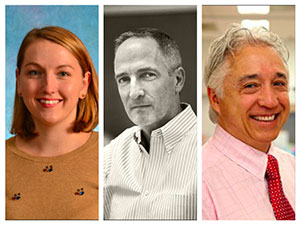HIV Targets Tissue Macrophages

Investigators in the Division of Infectious Diseases at the University of North Carolina School of Medicine have clearly demonstrated that HIV infects and reproduces in macrophages, large white blood cells found in the liver, brain and connective tissues of the body. This discovery has significant implications for HIV cure research. Macrophages ingest foreign material, including infected CD4 T cells. Past studies concluded macrophages became infected upon ingestion of compromised CD4 T cells. By studying the virus in novel small animal models that have no T cells (the cells that easily support HIV infection), researchers found HIV infected macrophages, proving macrophage-tropic strains of HIV exist and can autonomously replicate in these important cells. These findings were published in the Journal of Clinical Investigation on Monday, March 7.
“This study unequivocally demonstrates macrophages are a clear source of replicating virus,” said Joseph Eron, MD, study co-author, and professor of medicine in the Division of Infectious Diseases at UNC’s School of Medicine.
Macrophages are myeloid lineage cells. To determine if tissue macrophages are productively infected with HIV, the team used a humanized myeloid-only mouse (MoM) model. Using this model, they discovered macrophages can sustain HIV replication in the absence of T cells; HIV-infected macrophages are distributed in various tissues including the brain; replication-competent virus can be rescued from infected macrophages obtained from tisshttps://news.tracs.unc.edu/administrator/ues of MoM; and infected macrophages can establish infection in new hosts. These results demonstrate that macrophages represent a genuine target for HIV infection that can sustain and transmit infection. The study’s results also have implications for cure research.
“If the T cells were the only target of HIV cure research, eradicating the virus would still be tough,” said J. Victor Garcia, PhD, study co-author, and a professor of medicine in the Division of Infectious Diseases at UNC. “Now we have demonstrated that there is another cell target where replicating HIV can be found, which could make eradicating the virus from the host and finding a cure for HIV/AIDS harder.”
Now that Garcia, Eron and their teams know HIV targets macrophages and that the virus replicates there, the next step will be to introduce antiretroviral therapy into the models to see if the virus continues to replicate despite treatment.
“This model will allow us to ask the critical question as to whether or not macrophages represent a latent reservoir for HIV after treatment with antiretroviral therapy,” said Jenna Bone Honeycutt, PhD, lead author of the study and a postdoctoral fellow in the Division of Infectious Diseases at UNC. “These experiments will inform the future direction of HIV cure research as we know it.”
Drs. Honeycutt, Garcia, Eron and their teams in the Division of Infectious Diseases at UNC School of Medicine collaborated with scientists in UNC’s Department of Microbiology and Immunology as well as the Department of Microbiology at the University of Minnesota in Minneapolis. This study was funded through the National Institute of Allergy and Infectious Diseases and the National Institute of Mental Health within the U.S. National Institutes of Health.